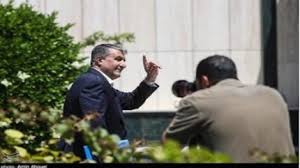
IAEA reported that “Iran agreed to the Agency’s request to increase the frequency and intensity of the implementation of safeguards measures at Fordow enrichment plant”. This came after IAEA said Iran had revamped Fordow so it could “significantly increase the rate of production of uranium enriched up to 60%.
“The IAEA has always had access to monitor within the framework of the safeguard agreement and the NPT [Nuclear Non-Proliferation Treaty], and we have not created any obstacles for it and we will not do so,” Eslami said.
In November, Iran announced it would launch “new and advanced” centrifuges in response to an IAEA Board of Governors’ resolution sponsored by the UK, France and Germany, censuring Iran for what it called a lack of cooperation with the Agency. In a letter to the UN Security Council, the three European powers also raised the possibility of restoring all UN sanctions against Iran to prevent it from further developing its nuclear programme.
The action of the three European countries was taken despite indications that relations between the IAEA and Iran were about to improve following a visit to Tehran by IAEA Director General Rafael Mariano Grossi. Briefing the Board of Governors on his meetings in Tehran, he described his discussions with the new government as constructive despite ongoing concerns.
“It is clear that the accumulation of enriched uranium at very high levels has been a matter of concern for many around the world,” Grossi said. “And this is why I requested the Islamic Republic of Iran to exercise restraint. Not only to exercise restraint but also, if possible, to stop increasing the stockpile of 60% uranium. And this request of mine was accepted by Iran.”
Grossi said this was an initial step, and a lot more needed to be done. “It is the duty of the IAEA to preserve the regime of which we are the custodians – the non-proliferation regime. And this has been at the heart of this important effort,” he noted.
Relations between Iran and the IAEA have been especially problematic since September 2023 when Iran withdrew the designation of several Agency inspectors assigned to conduct verification activities in Iran under the NPT Safeguards Agreement. Iran’s action came after the IAEA Board of Governors issued a statement accusing Iran of non-compliance with its safeguards commitments. The statement was initiated by the UK, the US, France and Germany. The Iranian Foreign Ministry also criticised the UK, France and Germany (E3) for their decision to retain the sanctions against Tehran in contravention of the 2015 Joint Comprehensive Plan of Action (JCPOA). The sanctions were due to expire but the three countries decided to keep them in place.
Under the JCPOA between Iran the P5+1 group of countries (the USA, UK, France, Russia, and China plus Germany) Iran had agreed to limit its nuclear development in return for the lifting of sanctions. However, after former US President Donald Trump withdrew from the deal and reimposed sanctions in 2018, Iran began to redevelop its nuclear programme when the European parties to the agreement failed to offer any compensation for the US’s withdrawal. IAEA had been monitoring Iran’s nuclear development programme.
Iran’s nuclear development has been impressive despite being under Western sanctions since 1979. Iran plans to have 20,000 MWe of nuclear capacity by 2041 and already has one Russian-designed VVER-1000 unit operating at the Bushehr NPP, with two more units under construction. In addition, it is constructing an indigenously designed NPP at Dharkovin on the Karun River and a larger NPP in Sirik as well as a new multi-purpose 10 MW research reactor at the Isfahan Nuclear Technology Centre (INTC). Iran also has all the necessary fuel cycle facilities to support its plans.
Recently Mohammad Eslami announced that the AEOI provides 69 domestically produced radiopharmaceutical products to consumers, which are used in critical medical applications. He made the remarks on Saturday during the unveiling of a new achievement by the Iranian Research Institute for Nuclear Sciences and Technologies – an indigenously developed high-power radio frequency generator, at the Technology Market Exhibition in Tehran. Eslami said this system includes the main and essential components of electron accelerators, which are urgently needed in the country. Eslami added that 20 radiopharmaceuticals are currently under research at the Research Institute for Nuclear Sciences and Technologies, many of which have entered the clinical phase and will be made available after completing the clinical stages.